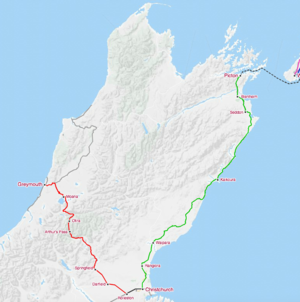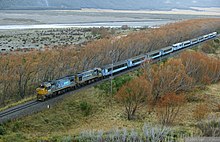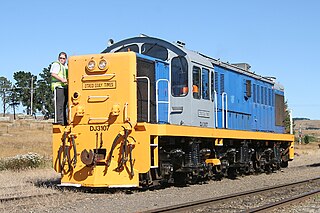
The New Zealand DJ class locomotive is a type of diesel-electric locomotive in service on the New Zealand rail network. The class were built by Mitsubishi Heavy Industries and introduced from 1968 to 1969 for the New Zealand Railways Department (NZR) with a modernisation loan from the World Bank to replace steam locomotives in the South Island, where all of the class members worked most of their lives. Nine of the locomotives remain in use, mainly with Dunedin Railways.
The Southerner was a passenger express train in New Zealand's South Island between Christchurch and Invercargill along the South Island Main Trunk, that ran from 1970 to 2002. It was one of the premier passenger trains in New Zealand and its existence made Invercargill the southernmost passenger station in the world.
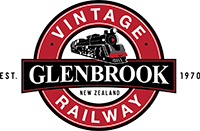
The Glenbrook Vintage Railway (GVR) is a heritage steam railway in Glenbrook, New Zealand.
The Endeavour was a long-distance passenger train service between Wellington and Napier in the North Island of New Zealand. The service was modelled on the Southerner service in the South Island, and operated from 1972 to 1989.
This is a list of jargon commonly used by railfans and railway employees in New Zealand.
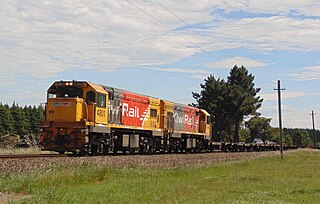
The New Zealand DC class locomotive is a type of diesel-electric mainline locomotive on the New Zealand rail network, operated by KiwiRail on freight trains, and formerly on long-distance passenger trains. The class was rebuilt from the DA class in the late 1970s and early 1980s, mainly in Australia. After the DA class, they were the most numerous class of diesel locomotive on New Zealand's railway network and remained numerically dominant until the mid-2010s when withdrawals began.
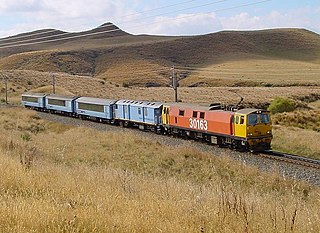
The Overlander was a long-distance rail passenger train between Auckland and Wellington in the North Island of New Zealand, along the North Island Main Trunk (NIMT). It was operated by Tranz Scenic. The service was replaced from 25 June 2012, by the Northern Explorer.

The Capital Connection is a long-distance commuter train operated by KiwiRail between Palmerston North and the capital city of Wellington on the North Island Main Trunk.
The Northerner was an overnight passenger train between Wellington and Auckland in New Zealand. The train replaced the unnamed and ordinary express trains supplementing the luxury Silver Star, which had replaced the Night Limited in 1971. The Northerner operated from 1975 to 2004.
The Bay Express was a passenger train between Wellington and Napier in New Zealand's North Island, operating from Monday, 11 December 1989 until Sunday, 7 October 2001. It was operated by New Zealand Railways Corporation's InterCity Rail division, later known as Tranz Scenic.

The Coastal Pacific is a long-distance passenger train that runs between Picton and Christchurch in the South Island of New Zealand. It is operated by the Great Journeys New Zealand division of KiwiRail. It was called the TranzCoastal from May 2000 until temporarily withdrawn in February 2011. It was the first train to use the new AK class carriages.
The Lynx Express was a long-distance passenger train in the South Island of New Zealand that ran the length of the Main North Line between Picton and Christchurch. The service was operated by New Zealand Rail Limited business unit InterCity Rail.

The Wairarapa Connection is a New Zealand interurban commuter rail service along the Wairarapa Line between Masterton, the largest town in the Wairarapa, and Wellington. It is operated by Wellington suburban operator Transdev under contract from the Greater Wellington Regional Council. It is a diesel-hauled carriage service, introduced by the New Zealand Railways Department in 1964 after passenger demand between Masterton to Wellington exceeded the capacity of the diesel railcars then used.
The Connoisseur cars were special railway carriages that were used in a number of passenger trains in New Zealand.
The Picton Express was a passenger express train operated by the New Zealand Railways Department (NZR) between Christchurch and Picton. It ran from December 1945 until February 1956, and was thus the shortest-lived provincial express in New Zealand. Following the end of railcar services in 1976, a new carriage train between Christchurch and Picton began, under the same name as the earlier service, until it was replaced in 1988 by the Coastal Pacific Express.

The NZR 56-foot carriage is a class of 56 ft (17 m) long railway passenger carriage formerly used on almost all long-distance passenger rail transport in New Zealand. 88 carriages have been preserved.
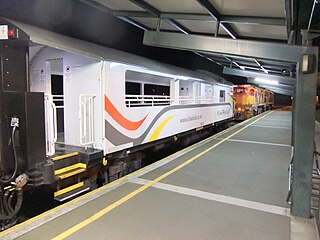
The New Zealand FM guards van is a rail vehicle in New Zealand originally used on freight trains but now used primarily on passenger trains, reclassified AG.

The New Zealand British Rail Mark 2 carriages were built by British Rail Engineering Limited for British Rail in the early 1970s. From the mid-1990s, 150 were exported to New Zealand. After being rebuilt, refurbished and re-gauged, they entered service with a variety of operators on New Zealand's railway network. The carriages generally replaced older NZR 56-foot carriages, some of which had been in use for almost 70 years.

The New Zealand AK class carriage is a class of 17 cars built by Dunedin's Hillside Workshops for KiwiRail's long-distance passenger operation The Great Journeys of New Zealand. Consisting of 11 AK saloon carriages and four AKC café carriages, supplemented by three AKL luggage vans and four AKV open-air viewing/generator vans converted from AG vans, similar to those previously used on the Coastal Pacific and the TranzAlpine. The AK class are the first new carriages to be built in New Zealand since 1943.

Great Journeys New Zealand is the tourism division of KiwiRail that operate its three Scenic train services. The new division was launched in May 2017 and replaced the former tourism brand KiwiRail Scenic Journeys. It has continuity with the earlier InterCity Rail (1987–1995) and Tranz Scenic (1995–2011).

